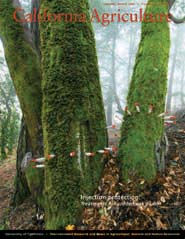All Issues

Injection protection: Treatments for sudden oak death
Cover:
In Redway (Humboldt County), spring-loaded mechanical syringes are used to inject phosphonate compounds into healthy tanoak trees, to study the effectiveness of this preventative treatment for sudden oak death (see pages 8 and 10). Photo: D.J. Schmidt/UC Berkeley





